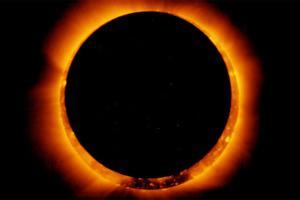A solar eclipse occurs when the moon comes in between the earth and the sun and when all the three bodies are aligned.

Pic/ AccuAstronomy's Twitter
Parts of India will witness a partial solar eclipse from Bhubaneswar on December 26 from 8:20 am to 11:28 am on Thursday. According to the Astronomical Society of India, the eclipse will be visible as a ‘Ring of Fire’ in some parts of southern India and partial in the rest of the country.
ADVERTISEMENT
When and where?
Considering the Earth as a whole the partial phase of the eclipse will begin at 8 am. The annular phase will begin at 9: 06 am and end at 12:29 pm. The partial phase will end at 1:36 pm.
The fullest eclipse would occur at 9:46 am with maximum obscuration of 54.7 per cent.
Obscuration of the Sun by the Moon at the time of greatest phase of partial eclipse will be around 90 per cent in Bangalore, 85 per cent in Chennai, 79 per cent in Mumbai, 45 per cent in Kolkata, 45 per cent in Delhi, 42 per cent in Patna, 33 per cent in Guwahati, 70 per cent in Port Blair and 35 per cent in Silchar.
How to watch the eclipse?
The ministry said that eclipsed sun should not be viewed with the naked eye, even for a very short time and cautioned that it will cause permanent damage of the eyes leading to blindness even when the moon covers most portion of the Sun.
A safe technique to observe the solar eclipse is either by using a proper filter like aluminized mylar, black polymer, welding glass of shade number 14 or by making a projection of Sun's image on a whiteboard by telescope, it said.
For those unversed, a solar eclipse occurs when the moon comes in between the earth and the sun and when all the three bodies are aligned. An annular eclipse occurs when the moon covers the sun's centre, leaving the sun's outer edges visible to form a 'ring of fire' or annulus around the moon.
(with inputs from ANI)
Catch up on all the latest Crime, National, International and Hatke news here. Also, download the new mid-day Android and iOS apps to get latest updates
 Subscribe today by clicking the link and stay updated with the latest news!" Click here!
Subscribe today by clicking the link and stay updated with the latest news!" Click here!






